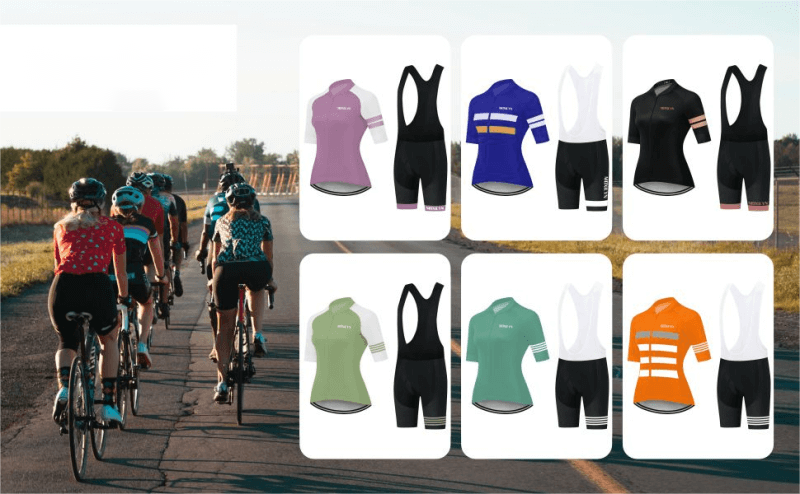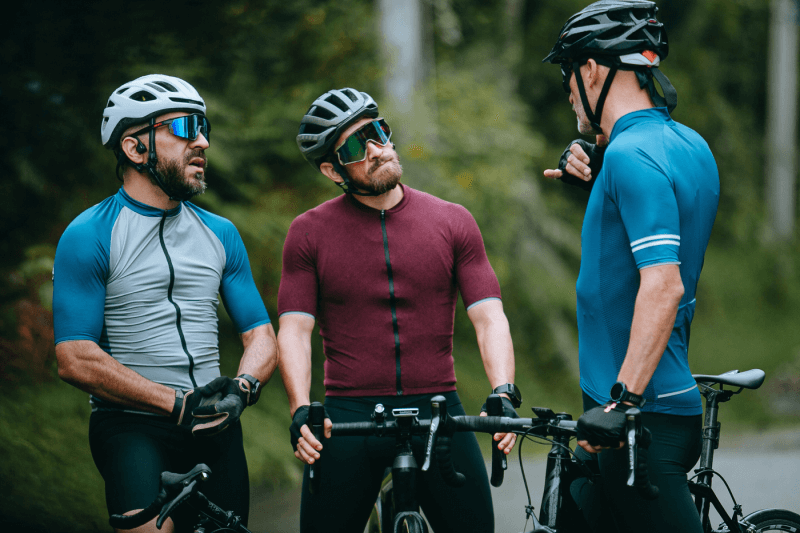Over the course of the past few years, there has been a major evolution in cycling apparel, with technological breakthroughs boosting performance, comfort, safety, and sustainability. Therefore, it is necessary for professional buyers and industry professionals to have a solid understanding of these advancements in order to make educated decisions regarding their purchases. This article provides a complete review of the elements that are altering the cycling business by delving into the cutting-edge technology that are integrated into cycling clothing.

The Most Innovative Fabrics and Materials
Technology that is both moisture-wicking and quick-drying
The regulation of moisture is an essential component of cycling apparel. Superior moisture-wicking fabrics, such as polyester blends and proprietary materials like Coolmax, are designed to draw perspiration away from the skin and encourage quick evaporation. These fabrics are also known as moisture-wicking fabrics. The use of these technologies helps cyclists avoid chafing, keeps them dry, and ensures that they remain comfortable even during extended rides.
Temperature regulation
The use of thermoregulatory materials has revolutionized the cycling apparel industry. These materials are able to adjust to the temperature of the body, allowing them to provide warmth in cold situations and cooling characteristics in hot weather. Thermoregulation is improved by technologies such as Outlast and Polartec Power Grid, which store heat and release it when it is required. This allows for the body to maintain an appropriate temperature and provides comfort.
The Fabrics of Compression
Supporting muscles, enhancing blood circulation, and reducing weariness are all benefits of compression technology in cycling apparel applications. Compression fabrics of superior quality, such as those utilized in compression shorts and jerseys, offer targeted support, improve performance, and speed up the recovery process. Companies such as SKINS and 2XU have created compression materials that are exclusive to cycling and are designed exclusively for the sport.
UV Protection (UV)
Due to the fact that cyclists are frequently subjected to lengthy exposure to sunlight, UV protection is an essential component of cycling apparel. These days, modern fabrics are equipped with UV-blocking characteristics, which shield them from the sun’s potentially damaging ultraviolet rays. The use of materials like as Lycra that have built-in UV protection helps to avoid skin damage and enhances comfort during rides in beautiful weather.
Improved Comfort and a Better Fit
Design That Is Ergonomic
When it comes to cycling apparel, ergonomic design ensures a precise fit, which in turn improves both performance and comfort. During the riding posture, clothing that are pre-shaped and anatomically constructed adhere to the body of the cyclist, hence lowering the amount of drag and increasing the aerodynamics. A customized fit that improves mobility is provided by features such as articulated elbows and knees, as well as construction with several panels.
Seams on a Flatlock
When it comes to preventing chafing and irritation, flatlock seams are absolutely necessary. This method of stitching is flat against the skin, which reduces the amount of friction that occurs when the garment is moved. The use of flatlock seams in high-quality cycling apparel helps to improve comfort, particularly in areas that are subject to a lot of motion, such as the shoulders and the underarms.
Innovations in Padding
The technology behind padding has undergone tremendous developments, particularly in the realm of cycling shorts and bibs. Padding made of high-density foam and gel provide support and cushioning, thereby lowering the amount of pressure that is placed on sensitive areas. The use of multi-density pads that come in a range of thicknesses provides tailored support, which improves comfort during extended rides. Padding technologies that are exclusive to certain brands, such as Assos and Rapha, have been created to improve both comfort and performance standards.

Features that are Functionally Innovative
Intelligent Wearables with Integrated Sensors
An important step forward in technical development is represented by the incorporation of sensors and wearables into cycling apparel. There are a variety of parameters that can be monitored by smart clothing that has sensors incorporated in, including heart rate, cadence, and body temperature. When it comes to smart cycling apparel, companies such as Hexoskin and Sensoria are at the forefront of innovation. These companies offer real-time data to improve both training and performance.
The use of LEDs and reflective materials
For bikers, safety is of the utmost importance, particularly for those who ride in settings with low levels of illumination. Materials that reflect light and LED lights that are built into the design improve visibility, making it more likely that vehicles will see bikers. Innovative designs embed reflective materials into the fabric in a seamless manner, while LED systems, such as those manufactured by Proviz, provide additional illumination for rides that take place primarily at night.
Facilities for Ventilation
Cycling apparel that incorporates advanced ventilation technologies assist in maintaining a comfortable body temperature and enhancing comfort. Mesh panels, vents that are strategically positioned, and holes that are laser-cut all work together to improve airflow and reduce overheating. Full-length zippers on jerseys and jackets provide for flexible ventilation, which enables cyclists to swiftly cool down when it is necessary to do so.
Enhancements to the Capabilities
Design That Is Aerodynamic
Aerodynamics are an extremely important factor in the performance of cyclists. Streamlined designs and clothing that fit snugly lower the amount of air resistance, which enables bikers to maintain higher speeds with less effort. The aerodynamic cycling apparel that has been developed by companies such as Castelli and Specialized uses dimpled textiles and seamless construction in order to reduce the amount of drag that is experienced.
Innovative Technologies for Eliminating Bacteria and Odor
As a result of their prolonged exposure to perspiration, cycling clothing is susceptible to the accumulation of odor and bacteria. The growth of bacteria that cause odors can be inhibited through the use of anti-bacterial and anti-odor technologies. Some examples of these technologies include silver ion treatments and unique anti-microbial fabrics. Even after prolonged usage, these technologies manage to maintain the cleanliness and freshness of riding apparel.
Improvements in Mobility
Mobility and comfort are both improved through the use of stretch textiles and innovative patterning processes. Materials that stretch in four directions allow for a full range of motion, while ergonomic cuts and seams that are strategically placed give a fitted fit that moves with the cyclist. The total performance is improved as a result of these improvements, which eliminate restrictions.

Innovations Focused on the Environment and Sustainability
As the cycling gear industry continues to evolve, sustainability is becoming an increasingly significant factor. Companies are now adopting recycled and environmentally friendly products in an effort to lessen their influence on the environment. Recycled polyester, organic cotton, and biodegradable fibers are becoming increasingly popular as materials for the production of fabrics. Patagonia and Vaude are two of the most innovative brands in the world of environmentally friendly cycling apparel.
Personalization and alteration of the product
Options for a Perfect Fit
Cycling apparel that is fitted to the wearer boosts both comfort and performance by providing a tailored fit. Made-to-measure services are provided by certain manufacturers, which involve the customization of garments to the specific measurements of the individual. Because of this level of customisation, the fit is guaranteed to be perfect, which significantly reduces discomfort and enhances aerodynamics.
Design that is Personalized
Because of the availability of unique design possibilities, teams and clubs are able to have their own colors, logos, and sponsor branding. In order to ensure that bespoke patterns are long-lasting and can resist the rigors of riding, printing and embroidery techniques of a high grade are commonly used. A wide variety of customizing choices are available from brands such as Cuore and Pactimo, which are available to both professional teams and amateur organizations.
The industry is undergoing a transformation as a result of the incorporation of sophisticated technology into cycling apparel, which is offering improvements in terms of performance, comfort, safety, and sustainability. Adapting to the ever-changing requirements of cyclists, these advancements include moisture-wicking and thermoregulatory materials, as well as smart wearables and designs that take aerodynamics into consideration. Keeping up with these changes is essential for professional buyers and industry experts since it enables them to select cutting-edge products that are in accordance with the highest standards of quality and performance. As technological advancements continue, the future of cycling clothing is expected to bring along even more signifi











